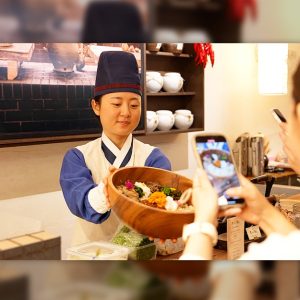“Daebak!” New Korean words are popping up in the Oxford and Merriam-Webster dictionaries every year, with many new words being food-related
The rising influence of “hallyu,” or Korean wave, extends beyond headphones, screens and dinner tables. It is also starting to reshape the way people speak and the word choices they make. Korean culture has become so widely known that now, almost everything prefixed with a K- signifies something Korea-related. Some examples include K-pop, K-drama, K-beauty and K-food.
Following this trend, a growing number of Korean words debuted in the Oxford English Dictionary (OED) – which Harvard University depicts as the dictionary with “the most complete record of English ever recorded.” Before 2020, Korean words were sprinkled around the OED’s website here and there, with only 20 words included in total. This figure more than doubled in 2021, with 26 iconic Korean words added, and new words continue to pile in every year.
A substantial number of these additions are due to the growing popularity of Korean food, as people in English-speaking countries develop a taste for Korean flavors and want to use the original Korean names to describe them. This year, the range is set to become even wider with the anticipated inclusion of words like “dalgona”, “jjigae” and “tteokbokki.”
Today, CJ Newsroom explores some of the classic Korean terms that English speakers all over the world are starting to embrace, as featured by the OED.
Top K-Food Vocab: Which Korean Words Are You Using?
– Banchan (noun): The sidekicks of a Korean meal, containing small side dishes of vegetables or meat served along with rice. Traditionally, three to seven banchans are prepared at home and served alongside the meal. The leftover food is often added to a lunchbox meal the next day called “dosirak (packed meal).” Nowadays, a wide range of banchan is readily available at local supermarkets and specialized banchan stores. These stores are not common globally but they have become familiar to people who often watch Korean dramas, which could be contributing to the popularity of the name. Additionally, in the restaurant setting, it’s customary to ask for more banchan if desired, reflecting the generous and hospitable nature of Korean dining culture.
Example: “Can I have some more banchan, please?” or “Are you here to buy some banchan?” “No, just a dosirak.”

– Chimaek (noun): Often enjoyed by Koreans for dinner or as a late-night snack, chimaek is a combination of the two foodie favorites: chicken and “maekju” (beer). This popular culinary pairing should not be confused with American-style fried chicken; Korean friend chickens’ double-fried batter, unique variety of sauces and added toppings offer a whole new dining experience. Chimaek is often enjoyed by Koreans for dinner, as a late-night snack and even gatherings with friends.
Example: “When there is chicken and beer in front of you, how can you not enjoy chimaek?”

– Kimbap (or Gimbap) (noun): Containing cooked rice and other ingredients wrapped in a sheet of seaweed and cut into bite-sized slices, many call this the Korean version of a sandwich. It’s a lunchtime favorite and a popular choice for picnics. Kimbap is often made at home in the morning before work or school and the ingredients are purchased at the supermarket in kimbap kits. Outside of Korea, kimbap is growing in popularity and bibigo’s kimbap brand in particular garnered huge success in Japan due to its variety of flavors. Just as burger shops can be found anywhere in the U.S., it is easy to spot a kimbap specialty store or snack bar at every turn in Korea.
* “Gimbap” is the colloquial way of spelling the term.
Example: “Why have you prepared so much gimbap? Are you starting a kimbap store?”

– Mukbang (noun): A genre of video, which tends to be a live-stream, of a person eating a large quantity of food while talking to an audience. Though more recently, this word is being used in a wider context to describe the general practice of “eating” alone or in a large quantity. A well-known example can be found on Cardi B’s Instagram where she posted a short video of herself eating corn dogs and spicy noodles.
Example: “I get to try a lot of franchise restaurants for my mukbang.”

– Samgyeopsal (noun): A Korean barbeque favorite starring thinly sliced pork belly cooked on a tabletop grill alongside vegetables like garlic, samgyeopsal is often elevated with side dishes such as kimchi or wrapped up in a lettuce leaf. The dish is eaten on all types of occasions spanning from a weeknight dinner at home to company bonding events. Its popularity also extends to Japan, the Philippines, Canada and plenty of other nations.
Example: “Samgyeopsal and Soju are a perfect combination.”












